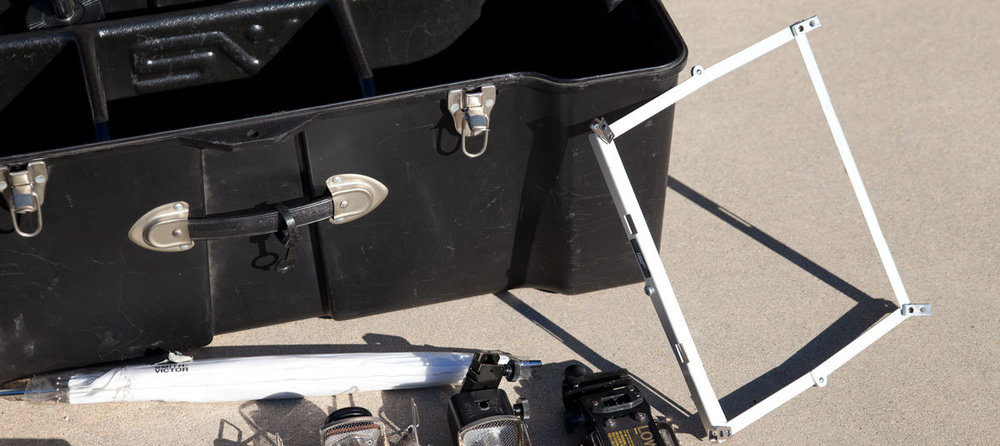-
Posts
282 -
Joined
-
Last visited
Everything posted by Stephen Sanchez
-
As of right now. Here in Florida/Georgia, some productions have popped up. All are a skeleton crew, available to those willing to work. The producer is sometimes skyped in on laptop with a minimum crew on location. Crew of four seems to be it, from talking to others. Masks on. Also, there is a strong shift toward remote productions. Aside from the above. I've seen traditional testimonials replaced with cell phone footage recorded by the talent themselves. It is intentionally DIY and video-chat-like representing the current times. Smart and cheap. A friend running a rental house in Tampa said he's had tons of requests for a Blackmagic Web Presenter which is supposed to take an SDI camera feed and trick a computer into thinking its a USB plug-in web cam.
-

Gels Melting on Open Face
Stephen Sanchez replied to Sam Bignell's topic in Lighting for Film & Video
Phil, I'd love some PhotonBeam 80 redeads! But they're so expensive, and low output comparatively. LEDs like the Aputure 120D, and Litepanels Astra are punchy enough for exact replacements. Still, though, no spot-flood :( FYI, Astras are low wattage (105w), but they get around this by sinking the LED emitters in little reflector cones, and gives them a spotty throw. The 6x versions might suggest they've formed a more efficient emitter. -

Mixing different LEDS: diffusion
Stephen Sanchez replied to omar robles's topic in Lighting for Film & Video
Whatever lights you get, do a test with them and your camera. I would make sure their white balance is similar Not every manufacturer sets daylight to 5600k. Some lights, like the Sokani X60 is at 6000k. This can be corrected with 1/8 or 1/4 CTO, but try to find matched fixtures so you're not always pulling out gels. Their product page would display the color temperature. There is however a magenta/green balance can can be present. It's not common among reputable manufacturers. Quasar Science did have a magenta-shifted batch of tubes a year ago that I got a hold of. So there's always a possibility. If you do ever have it, they can be corrected with plus green or minus green gel. They come in strengths of 1/8th, 1/4, 1/2, 1. I've found that 1/8 and 1/4 seem to be where LED shift can lie, but I haven't used all LEDs ever made (I heard AnandTech Punch shifts green by a large amount). -

Lighting Different Skin Tones
Stephen Sanchez replied to Sean Rudge's topic in Lighting for Film & Video
I was talking about for his experiment: finding an IRE for each skin tone on he Fitzpatrick scale he posted. The topic of exposure is subjective to each shooter, but it shouldn't keep someone from experimenting.- 14 replies
-
The 308X is a great light meter. I bought it when I came out. It's compact enough for a pocket, which is awesome. It slips into a side pouch easy. I do sometimes wish I had a one degree spot meter on it like the 758. Especially when im outside away from camera and need to meter the BG tree shade against the sky light, only to find it's 4 stops under when I place camera and look at it. But it's compact for a reason. Non-swivel head hasn't bothered me one bit.
- 9 replies
-
- light meters
- lighting
-
(and 2 more)
Tagged with:
-
I took the approach to light other DP's material for them. For free even. I collected my own lighting package and searcheed for local films offering to be their gaffer. So I served on paper as gaffer or lighting tech. But I was practicing my cinematography theory. This encourages you to have direct contact with the DP to bring the scene to life. And you get to see how they work and how they problemsolve. This was my choice. I felt camera operation was an easily learned technical skill, while lighting was subjective and tailored to the situation. I have a great passion for light, so it was a no-brainer. I got the idea after a FilmRiot interview with a DP who said he would gaff for other DPs on the side.
-

Lighting Different Skin Tones
Stephen Sanchez replied to Sean Rudge's topic in Lighting for Film & Video
@Sean Rudge, would it be better to correlate the skintone/exposure levels to IRE values? For instance, pale white at 70, dark African at 30? Because someone using a 2x3 softbox will have a different fixture solution than a 6x6 rag.- 14 replies
-
A lot of this is subjective to the shooter, which is why critiques can be difficult, and likely taken negatively. So without dictating you what to do, I'll share some pointers and criteria of importance I look at for a commercial production. 1) I pick a camera with high ISO range. FS7, FX9, EVA1. Even a Varicam or Venice will work. I find this important when shooting with small crews and small budgets. With your lighting package I would have used any of those cameras, the FX9 being incredible. I don't worry about sensor size, as all these are minimum Super 35. And on TV or internet, nobody cares about the capture method. 2) Exposure. I make commercials bright. If you haven't enough light/fixtures, you'll need a higher ISO camera. Narrative lighting invokes a mood and can get dark. Commercial lighting sells a product, and those faces are selling it. Shadows can and should be present, but those faces must be seen well exposed. For the guy and girl rancher, I would have wrapped the key so it reached her face more consistently, which (might necessitate a larger diffusion). For the hardhat lady, I would have ensured that her face was absent of that hat shadow with either a bounce card, or a sidey softbox. And if the window became too much, then I'd cut that. Personally, I would go softbox, because that would generate a killer eye light, which draws the viewer's attention (see below). 3) Edge light. You have great soft "skylight" in your scenes. Imagine putting in a sun along with that. But this isn't for arts-sake. Human eyeballs are attracted to contrast. And an edge light (commonly kicking the back in some fashion) will make your people pop. This is why shooters put the sun to the back on exterior shots. Just be sure it's believable. An edge on just the subject can appear artificial, and may need to extent to the whole set. Eye lights work in the same way. A sharp ping in the eye draws your attention. 4) Keylights will blow out on screen. You mentioned trouble with the window. I assume you were using it for the young couple's key. I chop the window down to acceptable exposure using ND, sheers, even a double net against the glass outside. Then I'll extend that window's light inside with a rag to push onto the talent. Because a keylight will blow out on screen, so don't show the key light on screen. Narrative can be different, buy that's because it can be a moody scene where the talent is keyed at 30 IRE (Man In The High Castle did this a lot). I keep my commercial key at 60-70 IRE, and 50 minimum. Personal note: I believe you're putting too much importance on the specs: Red, ISO 400, RAW, haze even. None of that matters in my opinion. In the stills I've attached, the boy was shot on an A7sII at 10,000 ISO, and the mayor campaigner on an FS7 at 1250 EI in S-Log3 only. I shoot log only as the editors don't have the time or storage to deal with RAW. It's just not needed. I hope this helps.
-

Green Screen Shoot in P-51 Mustang Cockpit
Stephen Sanchez replied to Grant Hobbs's topic in Visual Effects Cinematography
Beautiful! -

Gels Melting on Open Face
Stephen Sanchez replied to Sam Bignell's topic in Lighting for Film & Video
@Sam Bignell I still use open face fixtures (Redheads, Mighty Moles). The heat shield will disappoint you. It acts like shrink-wrap when it heats and glues to the color gel. I threw it away 30 seconds after striking the lamp. For open faces, the gel essentially needs to stay cool enough not to melt. This can be done with, 1) a loose clip to the barn doors, or 2) with a gel holder. My issue with clipping to the doors is that its not always far enough. So if you spot the beam the gel will begin to fade and crack in the center. And with 2K open face the heat of the doors themselves can melt a gel (this happened to me with a Rosco midnight blue, outside at night). Your best fast and cheap option is to extend the barn doors out by another 6" to hang the gel from. I think a lightweight plywood like Lauan would do the trick. (I'm unsure if paperboard/chipboard will tolerate the heat, but it's worth a try.) OR, find gel frames that attach to the light stand. I have a couple 21x24 collapsible frames by lowel that attach to the stand but they seem to be nonexistent on the internet. With 5K frenels, you can put gels in the "accessory slot" behind the arms that hold the barn doors. There are simple hinged metal rings just for this. This is not possible with open faces. I know lowel makes a snap-on glass dichroic filter (CTB) for their Omni Lights, and possibly for DP lights as well. Lowel in general manufactures great gel frames that attach to their lights, so gelling them is no problem. Also, a note. Rosco gels are very thin and melt within a minute on open face barn doors. Lee gels are much tougher. If I ever have to clamp to the doors, I always use my Lee stock as they last longer. I keep the more colorful range of Rosco gels in the lowel frames, always. Attached are examples of an insert gel frame, lowel attachable frame accessories, and a CTB dichroic filter on an omni light. -
I find this interesting because it was shot anamorphic onto a canon XL1 2/3" sensor and B4-mount 'broadcast' lenses. I think it just spat out a Rec.709 image, I'm sure it's dynamic range was limiting for Dod Mantle, BSC, ASC. I've not seen it since watching it on CRT television when it came out. This would be a fun re-watch.
-
I'm very interested in this. Can you elaborate? I've shot at extreme low light exposing with waveform and didn't notice issues. I am quite inexperienced though. Was there a best practice in those situations they recommended?
- 27 replies
-
I re-watched this to be sure. The cross pattern remains consistent. What you're seeing are circles (reflections of the flashlight) multiplied and overlapping. And the flashlight itself is not a solid blob; the reflector has a hot streak in it, giving each circle an uneven illumination. Giving appearance of wrinkles without motion. Having never worked with nets, I don't know their flare characteristics. I wonder if a filter added to the many circles.
-
Superspeeds and LowCons (as far as I know).
-
-
Am I correctly identifying this as a net or pantyhose? And is this in front or rear of lens? Screengrabs from Man in The High Castle Season 3.
-
Cain't wait to see your solution, friend!
-
Anyone else see this? I just watched it with the kids and it's beautiful. The exteriors look like they used natural light and shaped it. None of it felt staged. Even the nightime stuff doesn't play as overlit. I worked a couple jobs with kids and they're all over the place, so to me, it's super impressive that Sturla was able to keep a shape on all the shots of those kids' faces. All the shots. Watch it and you'll see what I mean. However slight, the shape is there. It was shot on 16mm. His use of colors (I'm assuming LEDs) in select scenes were wonderful. I'm referring to the caustics in the water cave and the shadows on the cave wall. "WENDY" YOUTUBE TRAILER RIGHT HERE
-

Getting Skin-tones this.. plastic?
Stephen Sanchez replied to Max Field's topic in Visual Effects Cinematography
Don't forget translucent powder. I know it doesn't help if you're already in post. But a double or triple dose of translucent powder will broadly soften secular highlights and kicks off the skin. It's like fairy magic. -
Well the point of the paper is to make a "seamless" backdrop. Stitching two paper rolls together will create a seam that you can't remove. It's thin paper and won't do what you want. But I do see a few options. 1. Have a smaller scale infinity wall made for your shot. This might depend on budget. 2. Find a really long seamless paper backdrop. Keep in mind that even an infinite length paper backdrop will not give lots of rotation room. 3. Look at doing a pass for just the product and a chroma screen behind it, then a separate pass for the backdrop on a longer lens to extend the travel space? 4. Spin the product instead of the camera. Then you can do it on a regular seamless. Lay the paper over a table, drill a hole through the table to stick the rod through attached to a spinning platter. They make electronic platters that give consistent spin as well.
-
Very nice. It was cute and charming. I think it would've been nice if the alley wasn't so well exposed. Maybe ISO down a full stop and lift their faces with a 4x4 card. Or even construct an extension to the 4x4 to hold a small dimmable LED fixture or a phone light to bounce into the board, as a mobile powered bounce card thing.
-

Lighting per shot vs environment
Stephen Sanchez replied to Doug Wolf's topic in Lighting for Film & Video
Everyone is pretty much on the same boat here. Yes, light the set and follow the actor around with a bounce card. Nothing wrong with that. My addition would be to, if you can, add an LED panel light to follow the actor around for their kicker as well. An Astra softbox with eggcrate works well, or create a snoot out of foamcore yourself to control the spill. LED kickers are great because they can be dimmed to an appropriate level and most are bi-color, so can play as spill from daylight or tungsten.




.thumb.jpg.3f494c48960427a50cd4949f789dc80c.jpg)




